[This series is a diary of our experience with raising chickens for our home flock. To see all articles in this series, please visit Home Flock Series.]
A man from the post office called at 8:23AM to let us know our baby chicks had arrived.
The chicks (all 40 of them) are healthy, energetic, and doing well. We have had a bit of a cold snap both yesterday and today and are expecting a few more days of cool weather, so we setup a 30 gallon plastic cow water trough indoors as a brooder. This will keep them contained, and the approximately one foot high sides and open top will allow plenty of ventilation. The plastic bottom will also keep any manure from leaking out, which would be a concern were we to use a cardboard box. In a few days, when the weather warms, we will move them to the homemade brooder out on our porch. We lined the floor of their temporary brooder with wood shavings to help soak up moisture then topped it with newspaper, so that the chicks can’t eat the wood shavings.
For water, we are using a plastic waterer. We filled it with lukewarm warm (slightly above room temperature) so that the chicks wouldn’t be chilled by their drinking water. We also added three tablespoons of white sugar per the instructions in the catalog. This will give them a little extra energy and help them to get off to a good start.
As we put each chicken into the brooder, I dipped its beak gently into the water so that it could get a taste and so that it would know where to find water.
We set out a tray feeder with chick feed crumbles and scattered some feed onto the newspapers on the floor of the brooder, so that the chicks could all find some feed easily. Most of them seemed to prefer eating the feed off of the newspapers rather than from the feeder. After watching them awhile, we were sure that all of them were eating and drinking.
We also recommend using Gro-Gel Plus on Day One. Gro-Gel Plus comes in a packet of dry powder. You add water to it, and it turns into a greenish gel that the chicks like to eat. It gives them water, nutrients, and vitamins and helps them get off to a good start quickly.
To keep the chicks warm, we rigged up a rack so that we could hang a 250W red heat lamp bulb over the brooder in a brooder fixture. Right now, the lamp is close to the top of the temporary brooder, and the temperature seems about right, since the chicks are scattered through the brooder fairly evenly. As they get older and their adult feathers begin to grow in, we’ll raise the light to give less supplemental heat. Watching how the chicks behave in the brooder is one of the best ways to tell if their brooder is at the right temperature. If they spread out and stay on the edges, away from under the light, that means it’s too hot for them. If they bunch together beneath the light, then they are too cold.
The breeds we got are Turkens, Americanas, Partridge Rocks, and Buff Rocks. We ordered mostly females and some males. We’re planning to raise the hens for layers and hatch some of their eggs so that we can raise their offspring.
- Americana / Easter Egger
- Partridge Rock
- Americana / Easter Egger
- Turken
- Buff Rock
- Box of Baby Chicks
- Baby Chick
- Baby Chicks in the Brooder

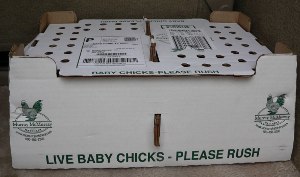
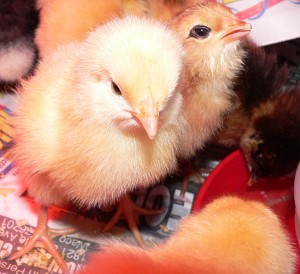
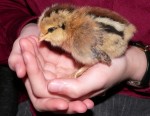
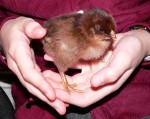

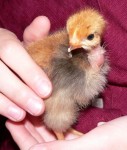
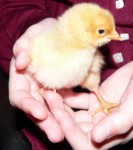

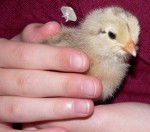

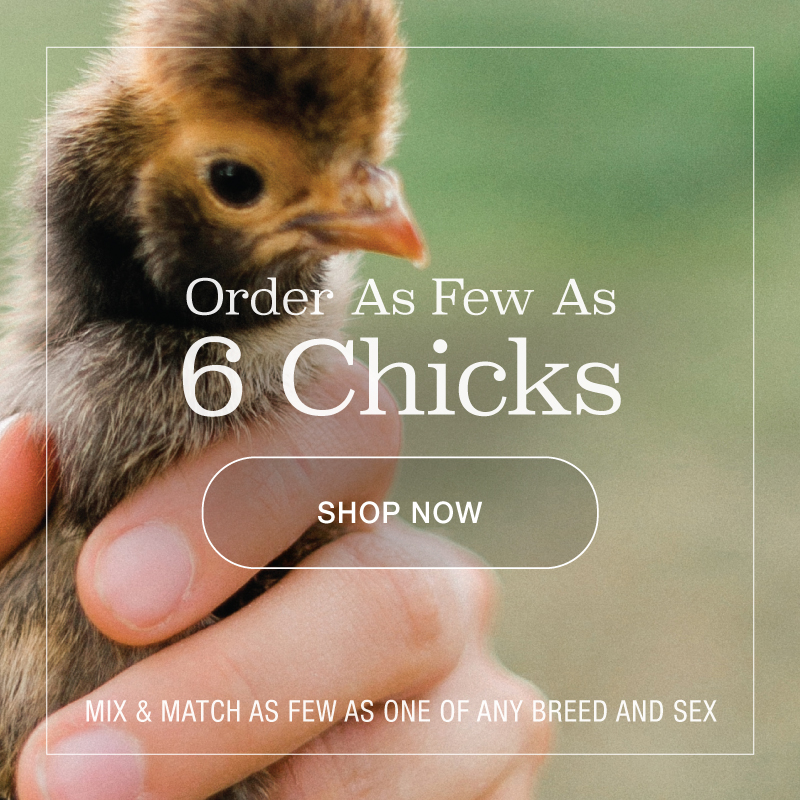

Dear Matthew,
I returned to download your egg recipes, for my 20 hens have been outdoing themselves, and was excited to see your baby chick blog. (I am new to the blog world.) We have over 50 little ones (Australorp, Amaracauna, Buff Rock, Silver-lace Wyandotte……..now 5 weeks old happy and healthy) from Murray McMurray, most of which my daughter and I plan to sell at fair in July. We opened our large dog carrier for the inside brooder, but discovered, after one escaped, that we had to duct tape the wire openings on the lid. My husband did ‘chickie CPR’ on that poor little one, cold and lifeless on the concrete floor, and she came back around nicely. I have enjoyed listening to the wee ones ‘talk’ as another measure of whether they are happy. I hope to pass on your tales to our “Rockin’ Roosters” 4-H club and to the 400 4th graders we will see Thursday at our local Farm Fair. Thanks for being a great teacher!
I’m counting the days until I know my “eggs” will go into incubation. They are due to hatch June 18 so I’ll really be counting after the first of June. I placed my order so that we would get the variety we wanted. At 75 I’m restarting a flock again. They have been a joy all my life, each time I get McMurray chicks. Of course I’m always waiting to see what “free chick” they will send me. Since I’ve done this many times before, I know what to do when getting them. And I always have them vaccinated. It helps to know you have a clean flock to start with.
I got some Pearl White Leghorns from McMurray in 2005. Well they won’t set, so I made a hatchery from a igloo cooler and a old house thermostat and 40 watt light bulb. By recalibrating the thermostat and putting in a thermometer I kept the temperature from 98 degrees to 101, and I have beautiful chicks every spring. Big white eggs.
How enjoyable, just change the slick flooring out. Material such as newspaper or cardboard is never recommended as it presents leg problems to the developing tiny legs of the chicks.
Once spraddle leg is no longer a potential problem after a week old, you can start using newspaper for flooring/ bedding without any issues, but not until they are old enough for the hip and hock joints to be set and musculature formed and toned.
We recommend covering the litter/bedding with newspaper the first day and spreading some feed on the tops of the newspapers (in addition to the feed in their feeders) so that the chicks can easily find the feed. Using newspaper the first day prevents the chicks from eating their bedding (wood shavings) rather than eating their food.
This was very informative. I have been raising chicks for many years now and never thought about using a water trough. I was looking for a cardboard box to put mine in (due in 2 weeks) but will use a trough that is just sitting out back. Also, I had not heard of putting sugar in the water so I will try that. Thanks so much for the “new” ideas.
Ellen,
I too just raised 12 in a cow/horse water trough as they are talking about and it works fabulous! I am expecting another 25 chicks the end of the month and will use the same thing again! I am new to this, but am eager and learning from everyone on this site!!
As a child, my family raised chickens at our house – 6 Rhode Island Reds. Nothing beats a fresh egg. And “the girls” were fun watch and play with (quite friendly). As an adult, I’ve wanted to raise a few hens but I’m not sure how to get started. I’ll be reading your Home Flock series to see if it will give me the confidence to get started.
I am pleased to see this blog/report. I plan on raising my own also, and this could help me stay on the right track….Thank’s